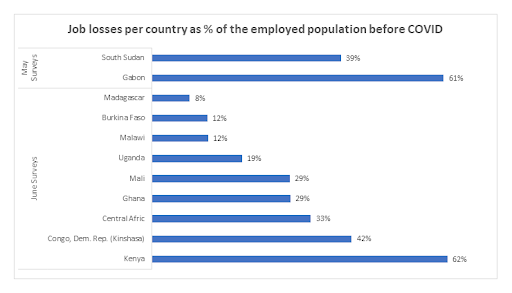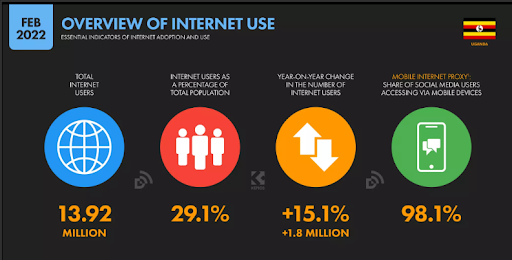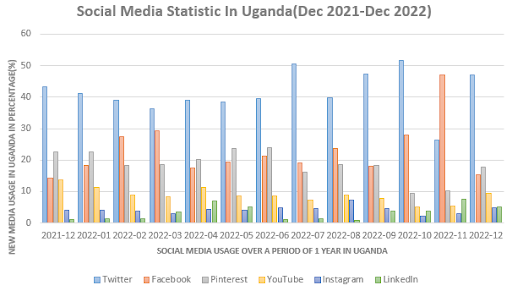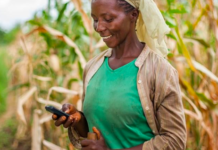By Moffin Opilio and Christine Awor
Nairobi, Kenya: Since the onset of COVID-19, there have been layoffs across the globe in various industries. In East Africa, several businesses- especially in hospitality, transport, horticulture, and media – buckled under the weight of the pandemic, leading to massive layoffs and furloughs of about 38 million people in the region. This is according to the data released by the UN Economic Commission for Africa (UNECA), entitled Economic and social impacts of Covid-19 in East Africa.
Graph showing the rate of layoffs in African countries since the onset of Covid-19. Source: COVID-19 High-Frequency Monitoring Dashboard
A look at Kenya
A further look into the Kenyan statistics showed that the media industry has since been top of the charts in laying off its workers. About 300 journalists have been laid off from notable media houses like Nation Media Group, Standard Media Group, and BBC since the onset of covid-19.
Speaking during a press release, ICT Cabinet Secretary (CS) Eliud Owalo confirmed that the Kenyan media has been struggling to stay afloat. The CS further admitted that the media disruptions had affected revenue streams, pushed the transition from traditional to digital media, and left a negative impact along its path.

According to economic experts, there are three kinds of companies laying off employees right now: those for whom the debt is becoming more expensive amid COVID-19 tightening, those uncertain about the economic outlook, and those using the economic climate as an excuse to cut employees they would have let go anyway.
Making lemonades out of lemons
Lydia Kipngetich, 24, is a casualty of the purge. She was fired by a renowned media group in Kenya in July 2022. She recalled receiving an internal memo from the management detailing a need for refocus that would result in a re-organization of the workforce, something she had not anticipated.
To make ends meet, Kipngetich relied on her video editor job at the media house and with nothing else on her plate, she was hopeless for a minute.
“I was confused about what to do. Being the sole breadwinner in a family, I had to rise up and get it moving. I tried looking for another job, but there were no other jobs. There was no hiring. I thought: what can I do? Then an idea came to mind,” said Kipngetich .
With knowledge of both traditional and digital media, Kipngetich joined the creator economy as a digital creator. Judging from statistics, she knew she could make something out of the huge population using social media in Kenya.

Graph showing social media consumption in the country. Source; digital 4africa.
Having seen a couple of social influencers transform their lives, She knew that creating something engaging and interesting for social media users to enjoy would earn her a following, which can be converted into a revenue stream.
Hence, she began educating herself: researching information online, reading topical books, and following key highlights on women and entrepreneurship, to which she carved a niche.
Soon, she started amassing followers as predicted. “I started with zero followers in July 2022 and by the end of the year, I had five thousand, six hundred followers,” said Kipngetich, “It was a huge surprise to me when barely two months into the creator business, notable brands reached out to me requesting for my influencer rates.”
According to the social media influencer, her growth rate has been rising since the inception of her page. She noted that consistency, professionalism, and quality deliverance have been her key pillars.
As a digital creator, Kipngetich considers herself a solopreneur and has taken it upon herself to also educate interested women on fending for themselves online.
“The creator economy has infiltrated almost every industry and is reshaping how consumers think about work and making a living. With the vast niches that exist, I believe there is a market for each and every digital content creator in Kenya and in the world,” she said.
Kipngetich explained that her life has since changed and now earns thrice more compared to her salary during her employment days. “When I think about it, COVID-19 and my dismissal from work was a blessing in disguise,” she said.
A look at Uganda
Uganda was not left behind amid the mega reshuffles in the global media industry.
A few months ago, Uganda’s conglomerate Next Media Services, a mother company to 8 brands, laid off a total of 30 journalists in what officials termed as digitizing operations.
Weeks preceding the reshuffle, the media company ran an advert on their Twitter platform in search of 50 digitally fit employees to replace those reshuffled, some of the positions in question were: online content editors, digital journalists, and platform managers among others.
According to the Digital 2022 Global Overview Report, Uganda had Internet connectivity of 13.92 million Internet users in January 2022 and an Internet penetration rate that stood at 29.1 percent of the total population at the start of 2022. This is an increase of 1.8 million (+15.1 percent) between 2021 and 2022.

The COVID-19 pandemic expedited the digitization process in Uganda, and this has increased the amount of information available. A decade ago, 40% of Ugandan journalists were accessing the internet through cyber and shared computers. They didn’t have the skills or software to navigate cyberspace according to the Human Rights Network for Journalists-Uganda (HRNJ).
Today, a number of organizations offer training which has made many journalists embrace new media.

Figure 1. A Graph Visualizing the Social Media Usage In Uganda between Dec 2021 –Dec 2022) Courtesy Of Statcounter Global Stats Research
Where are the gaps and solutions?
Isabella Ajok, 26, is a survivor of the trend. Like Kipngetich from Kenya, Ajok was laid off from a renowned media house but she has grown to embrace and master the art of new media.
When the storm sailed, she lost hope of being a respected media personality. She was faced by a myriad of challenges ranging from: depression, choking bills, keeping her children in school as well as provision of good medical services.
“Through training opportunities like Thomson Reuters Foundation’s digital training for journalists, HRNJ training on digital safety and migration, I was able to gain knowledge of digital media and this made me relevant in the industry,” Isabella attributes.
Through the training, Isabella was able to get equipped with skills like managing social media platforms and measuring analytics, engagements and quality content, social media campaigns, marketing, and the changing digital media trends and this made her a tech-savvy journalist.
Currently working for Nile FM, she appeals to journalists to always never run away when disaster strikes but rather look for ways of gaining skills through other engagements.
HRNJ chairperson, Julius Esegu, advises that journalists should endeavor to experience the horizon of incorporating various digital tools.
“Every medium now is about speed, time, and accuracy. As a journalist, one should use the available tools to better their work and as a Rights body, we continue to roll down on capacity building to keep journalists up to date,” said Esegu, “ Journalists need to explore opportunities at the national and regional level to be self-reliant as they execute their duties.”
This publication was produced with the financial support of the European Union. Its contents are the sole responsibility of Moffin Opilio and Christine Awor and do not necessarily reflect the views of the European Union.














